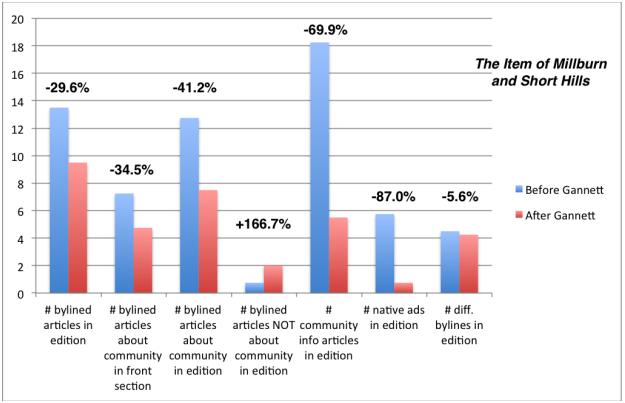The impact these layoffs have on the local news ecosystem of New Jersey isn’t hard to imagine. Other news organizations serving New Jersey have also relentlessly cut staff. The New York Times, which serves parts of New Jersey, doesn’t have a beat reporter covering the state (“Look, I wish we had the resources to have what we used to have in New Jersey and Connecticut, but the reality is that we don’t,” executive editor Dean Baquet told the Times’s public editor in January.)
How bad are the consequences, exactly, for both the laid off reporters, and for the residents of a state that now has a vastly diminished press corps? And what, if anything, can be done now to rehabilitate the New Jersey news ecosystem? (Warning: Depressing findings about the state of media in the Garden State ahead.)
Montclair State University’s Center for Cooperative Media has a new report out today that puts a few hard numbers on what we all already know — that many of the reporters laid off in the past decade in New Jersey have decades of local news reporting experience under their belts, and a decline in articles published as well as a marked decline in articles explicitly about and for the local communities. (This report analyzed a sample of four news weeklies acquired by Gannett: The Montclair Times, The Item of Millburn and Short Hills, The Nutley Sun, and Belleville Times.)
Here, for instance, is the change at the weekly Item of Millburn and Short Hills, pre and post Gannett:

From the report, written by Sarah Stonbely:
Perhaps the most important finding is a decrease in bylined articles about the community, what would traditionally be recognized as substantive “hard news.” These are articles with headlines, bylines, and often pictures, about local government, development and other topics that require some level of investigation. The loss of this type of article ranged from 9.9% fewer, in The Montclair Times, to 41.2% fewer, in The Item.
The numbers actually under-represent the decreases in bylined articles about the community, because what we saw was that some of the bylined articles in post-Gannett editions were actually identical in content to what had theretofore been community information articles. In other words, in the pre-Gannett papers, we saw many small items, with headlines but without bylines, that were about happenings in the community, placed alongside bylined articles, often citing multiple sources, that would be recognized as substantive “hard news.”
In the post-Gannett papers, these substantive articles were fewer in number, as documented in the findings, while the bylined articles that were present were often promotional in nature (while the number of community-information articles decreased).
Back in December, the Center for Cooperative Media1 convened a “Life After The Newsroom” event for laid-off reporters. A small survey of attendees found that half of those who responded had 20 years or more of experience when they were let go (only about a quarter of attendees filled out the survey).

Of the small sample, many remain unemployed or underemployed: “Several indicated they are working, but under less-than-ideal circumstances: as freelancers, at non-journalism organizations, or at trade publications. One person is at a local online journalism start-up.”
The Center suggests as paths forward more actively funding local news startups and existing news outlets (see: the new weekly broadsheet, Montclair Local), as well as local campaigns to remind New Jersey residents of the importance of their local news sources. It also suggests the creation of a statewide pool of reporters:
There are currently dozens of experienced journalists looking for work and dozens more about to join them. We think there has to be a powerful way to harness that talent and put it back to work for the benefit of communities. We’d proposed building off the successful Washington Post Talent Network model and creating a New Jersey talent network. Our talent network would be focused on bringing New Jersey writers, editors, photographers, copy editors, videographers, artists and others who are available for hire together in a pool accessible to companies, nonprofits, media orgs and other institutions looking for communications help. This network could also serve as the basis for other future local news and information-focused projects.
You can read the full report here.
5 comments:
Baby arowana for sale
Baby arowana for sale
https://analysis.fc2.com/redirect.php?r=https://www.facebook.com/profile.php?id=61554879615134
Why viewers still use to read news papers when in this technological world everything is presented on net?
Asking questions are really pleasant thing if you are not understanding anything completely, however this post provides good understanding
even.
Trackbacks:
Leave a comment